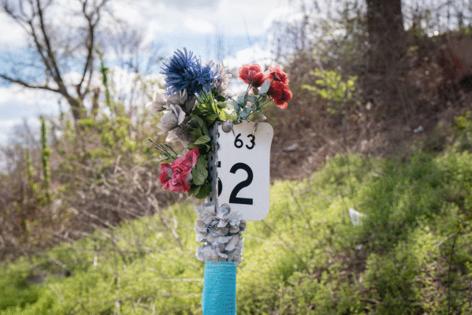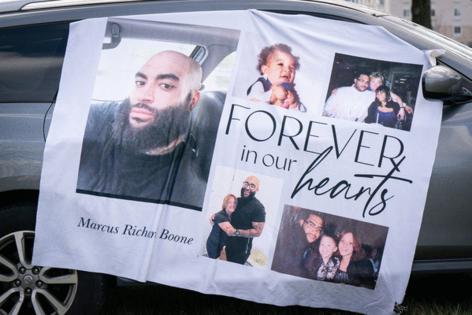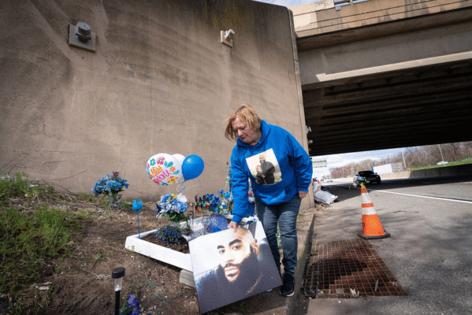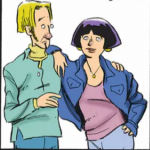Her son died by suicide. Responding police took a photo of his body and it ended up online, lawsuit says
Published in News & Features
PHILADELPHIA — The worst day of Karen Brookins’ life was March 18, 2022 — the day her first-born child, Marcus Boone, died by suicide.
The second-worst day, she said, was when she learned that a Philadelphia police officer who responded to the scene took a picture of her son’s body — and then shared it with others.
Two years after Brookins’ 39-year-old son jumped to his death from a highway overpass in Northeast Philadelphia, she has filed a lawsuit in federal court alleging that in the immediate moments after Boone hit the ground below, a police officer leaned over the railing and took a photo of his body, lying on the pavement. The image later circulated on the internet and ended up in the hands of a stranger who unknowingly showed it to the grieving mother.
Brookins learned of the photo a few weeks after her son’s death, when she returned to the area desperate for more information about what happened in the three hours police spent with Boone, trying to talk him off the ledge before he ended his life. She visited the gas station across from the overpass, she said, and asked an employee whether he had heard about the man who jumped a few weeks earlier.
“Oh my God, yeah it’s crazy,” she said the man told her. “I got a picture of him laying in the road dead. Wanna see it?”
Brookins nearly fainted. She asked him how he got it.
“One of my cop buddies took it,” she said he replied.
He asked for her phone number, she said, then sent her the photo.
She peppered him with questions: Who sent the photo? What’s his name? He said he couldn’t remember, Brookins said. Then, realizing she knew the victim, she said he warned her that “cops around here don’t like people talking.”
She walked to her car, stared at the photo, and sobbed.
The picture, she said, is burned in her memory.
“This is my world. This is my son,” she said in a recent interview. “And they’re taking pictures and sending it around? Why?”
And the worst part of all, she said: “My son was still alive when that photograph was taken.”
In her lawsuit, Brookins said the taking and sharing of the photo violated her right to privacy and exacerbated her pain and trauma.
The Philadelphia Police Department declined to comment because of the ongoing litigation.
Lawyers for the city have asked a federal judge to dismiss the case, saying that while “there is no doubt that (Brookins) has suffered a tragic loss and has been further subjected to callous actions by the individuals who shared a sensitive photo,” that does not meet the threshold of a civil rights violation.
A judge has not yet weighed in.
Brookins’ lawyer, John Coyle, said police had secured the scene and were the only people with the vantage point to have taken the photo.
“No members of the public were in a position to lean over the railing and take that photo,” Coyle said, adding that the image was shared across various social media platforms, including Facebook.
Police officers taking photos at crime scenes is not a new phenomenon. The widow of NBA All-Star Kobe Bryant settled a lawsuit with Los Angeles County for $28.5 million last year after first responders were found to have shared grisly photos from the scene of the helicopter crash that killed Bryant and his daughter. And a New York woman recently filed a lawsuit against transit authorities who she said shared a photo of her husband after he was shot to death on a train platform in January.
But Brookins’ frustration with how officers treated her son that day goes beyond the photo. She said the few conversations she’s had with police made her feel like a nuisance, and that detectives did not answer her key questions — like what her son told police before his death, and why no one called her or set out an inflatable device below the overpass in the three hours he spent contemplating jumping.
In the absence of answers, she has spent the last two years hunting down witnesses, surveying nearby businesses, recovering videos taken by bystanders, and filing public records requests, desperate to piece together details about her son’s final moments.
“Those answers are everything to me,” she said.
‘Life was very painful’
Boone was born in Bristol and was raised in the suburbs of Philadelphia. He had faced mental health troubles from a young age, Brookins said, partly caused by difficulties he faced as a child after his parents separated.
Boone was vibrant, though, she said, often hiding his pain with a brave smile and keeping busy with sports and hobbies like cooking.
“Everything he loved and did, it was with a passion,” Brookins said. Being a father to his now-22-year-old daughter was the highlight of his life, she said.
But Brookins said her son started self-medicating with drugs to ease his mental health issues, which included bipolar disorder, depression, and paranoid schizophrenia. He struggled with addiction, she said, and spent months in jail at various points for crimes related to drugs, retail theft and robbery.
“When Marcus was clean and in his right mind with his love and support … he was unstoppable. He was brilliant, very intelligent,” she said. “But life was very painful.”
Boone was living at the Gaudenzia recovery house in early 2022, Brookins said. She and her son had come up with a plan for the months ahead, and he seemed to be in a good place.
But on the morning of March 18, 2022, Boone called his mother and said that he didn’t feel well, that his stomach hurt. She told him to go to Jefferson Hospital to see his doctor. She would meet him there.
Brookins, who lives in Pleasantville, N.J., said that when she still hadn’t heard from him after a few hours, she got into her car to drive to the hospital. But as she reached the Walt Whitman Bridge, traffic was completely stopped. She was stuck.
Then her phone buzzed. It was a text from her niece, with a screenshot from the Citizen crime app showing a grainy image of a man standing on a highway overpass at Knights and Woodhaven roads in Northeast Philadelphia.
It was her son.
Searching for answers
Brookins immediately dialed 911, desperate to know if the man standing on the ledge was, in fact, Marcus. The dispatcher confirmed it, and said police were taking him to the hospital for treatment.
She thought that meant he was OK. But when she reached Jefferson, doctors told her that her son had jumped from the overpass and suffered catastrophic injuries. Brookins sat with her child in his final moments, holding his hand, telling him how much she loved him. He died at 2:15 p.m.
There were no police officers at the hospital, she said, and no one from law enforcement reached out to explain what happened. A nurse passed along the name of an officer who’d brought Boone to the hospital, and Brookins called him the next morning, hoping for clarity.
But the detective, she said, was cold and gave little information. A lieutenant she spoke with later was the same, she said. She stopped reaching out to police because she felt rejected and intimidated. She started seeking answers on her own, combing the internet for witnesses and surveying nearby businesses for surveillance footage.
Police said her son was on the ledge from 8:30 a.m. to 11:43 a.m. that day. And she learned, through witnesses and videos she reviewed from bystanders, that during those three hours, he yelled his name and birthday to police, and asked for his mother.
But no one called her, Brookins said, and Boone was brought to the hospital as a John Doe. She also wonders, she said, why police did not deploy an inflatable device below him given the length of time he spent contemplating ending his life.
Lisa Beckler was there, and said she is haunted by the public and police response. She said some people in their cars, frustrated by the standstill traffic on busy Woodhaven Road, yelled at Boone to jump because they were late for work. Others were visibly upset with the police, questioning why there was not an ambulance or crisis responders on standby, she said. Then, in the last hour, she said, SWAT officers showed up with dogs. Boone started yelling that the police wanted to kill him.
Beckler said she tried to drown out the negativity by yelling to Boone that he was loved, that there was a future beyond this moment, that his family would be here soon.
“I didn’t know him, but he belonged to somebody,” she said. “It could have been my son up there.”
She’ll never get the image of him jumping out of her mind, she said.
‘I love you’
Brookins’ daughter, Jasmine Washington, 36, said she has watched her mother’s physical and mental health deteriorate during her search for answers about Boone’s death. It is agonizing, she said, to know that hundreds of people watched the final hours of her brother’s life, but no one will explain what happened.
But most of all, she said, she wants to know who took the photo of her brother — and why.
The family formed a Facebook group to help in their search for information.
On the second anniversary of Boone’s death, the family gathered at the overpass. They prayed, shared their favorite memories of him and added to a growing memorial on the side of the highway.
At 11:43 a.m., they released blue and white balloons into the wind.
“I love you baby,” Brookins said as she let go.
Her tear-streaked cheeks glimmered in the sunlight as she looked up to the sky — watching each balloon fly out of sight, staring into the clouds as if they might hold answers to the questions for which she’s so desperate.
_____
©2024 The Philadelphia Inquirer. Visit inquirer.com. Distributed by Tribune Content Agency, LLC.












Comments